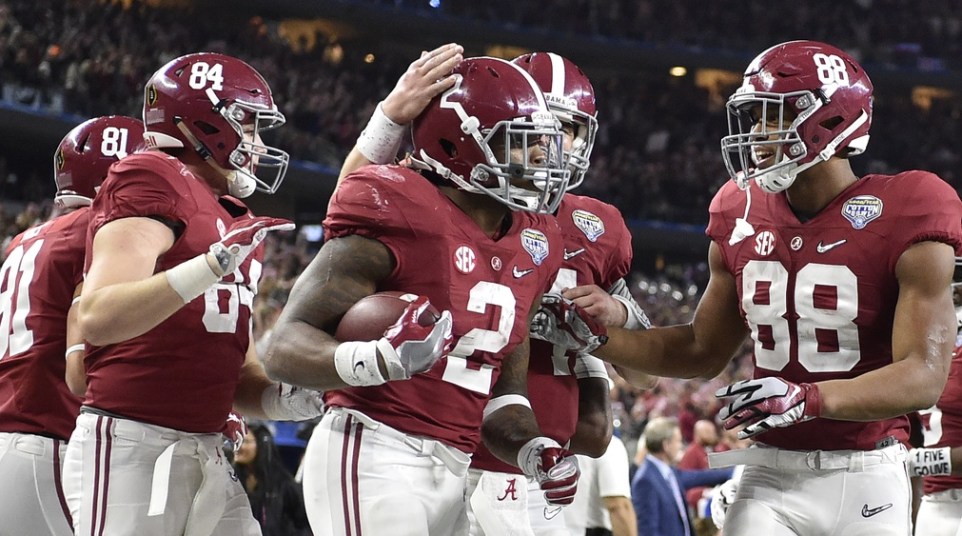
Early look: Alabama vs. Clemson in national championship
It’s a Happy New Year for Alabama, which will face Clemson in college football’s National Championship in Glendale, Ariz. on Jan. 11.
The most telling thing about the Tigers’ 37-17 victory over Oklahoma on New Year’s Eve is that Clemson had 312 rushing yards while holding Oklahoma to just 67. The scary thing is that the Tigers shut down the Sooners’ rushing attack without Shaq Lawson, their best defensive player, who sat out the second half because of a knee injury.
Early prognostications list Alabama as nearly a touchdown favorite over Clemson.
Here’s a quick look at both teams, on a position-by-position basis:
Quarterbacks: Clemson’s Deshaun Watson was masterful against Oklahoma, running for one touchdown, passing for another and accounting for 332 yards. Jacob Coker had a career night, completing 25 of 30 passes for 286 yards and 2 TDs. The biggest difference between the two signal-callers — and it’s a big one — is that Watson can run, and Coker clearly can’t.
Running backs: Wayne Gallman burned the Sooners for 150 yards and 2 TDs on 26 carries. Derrick Henry, his Alabama counterpart, finished with a very methodical 75 yards and 2 TDs on 20 carries. Coker was so good, there was no need for Alabama’s Heisman Trophy winner to run 45 times like he had averaged over his previous two games. The Crimson Tide held the Spartans to just 29 yards on 26 carries, so the running back who wins the rushing battle a week from Monday will definitely earn it.
Wide receivers, tight ends: In Artavis Scott, Hunter Renfrow and Charone Peake, Clemson had three receivers with at least four catches for 54 yards against Oklahoma. Renfrow caught Watson’s lone passing TD. Against Michigan State, Alabama’s Calvin Ridley was magnificent, leading the Crimson Tide with eight catches for 138 yards and two scores. O.J. Howard had arguably his best game of the season with 3 receptions for 59 yards, and Richard Mullaney averaged 17.7 yards on his three grabs. If Howard has another productive game, the Tide might have the edge in this department, even against All-ACC tight end Jordan Leggett.
Offensive lines: Both teams’ respective groups are among the best in the country, blocking for two of the best running backs in the country while keeping their QBs upright most of the time. Clemson has surrendered 16 sacks while Alabama has yielded 21. Tackles Mitch Hyatt and Joe Gore, guards Eric Mac Lain and Tyrone Crowder and center Jay Guillermo make up the Tigers’ offensive line.
Linebackers, defensive lines: Lawson’s injury gives the Crimson Tide a decided edge here, but Clemson defensive tackles Christian Wilkins and Carlos Watkins have been standouts. Ben Boulware leads the Tigers’ linebacking corps, but they don’t compare to Reggie Ragland and the rest of Alabama’s front seven.
Secondaries: The Tigers had the nation’s fifth-best pass defense and had held opponents to an FBS-low 46.1 completion percentage entering the Orange Bowl. Safety T.J. Green and cornerback Cordrea Tankersley, both juniors, are two big reasons for Clemson’s success. They, along with strong safety Jayron Kearse and cornerback Mackensie Alexander, are all draft eligible, and they’re all good.
Alabama’s Eddie Jackson and Geno Matias-Smith, along with fellow defensive backs Marlon Humphrey and Minkah Fitzpatrick are a solid group. But the wild card for Alabama, at least on special teams, is cornerback Cyrus Jones, whose punt return for a TD against Michigan State gave him four on the season to extend his FBS lead.
Overview: Clemson is clearly stronger at quarterback; the running attacks are pretty close. But Alabama’s defense is better, which is the reason the Crimson Tide is favored and it will be the difference when the teams meet in 10 days.
